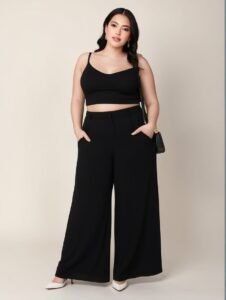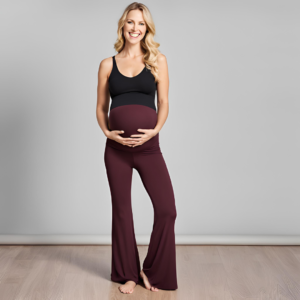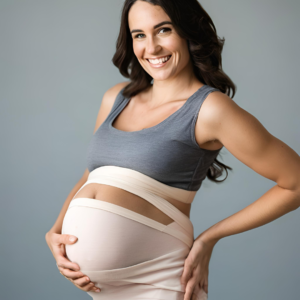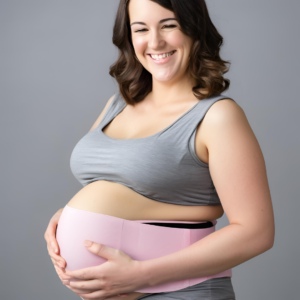Finding the right maternity pants that fit comfortably and stay up throughout your pregnancy can feel like an uphill battle. I just bought these new maternity pants that were super cute and tried them out for the very first time just to find out that they don’t really stay up on my waist with my growing baby bump. Bending over would make them constantly slide down and pulling them up has become an arm workout. Ugh! It’s definitely frustrating, to say the least. As your body changes, especially during the later months, pants that used to fit perfect can start slipping down. It’s incredibly frustrating to have to keep pulling your pants up every few minutes, right? But don’t worry—there are simple tricks and solutions to make sure your maternity pants stay put, no matter how big your bump gets!
Key Takeaways:
- Proper Sizing is Essential: Choosing the correct size for your maternity pants is crucial. As your body changes, so should your pants. Ensuring a proper fit can prevent slippage and provide the support you need.
- Supportive Accessories Make a Difference: Using accessories like belly bands or suspenders can significantly enhance the fit of your maternity pants, helping them stay in place throughout the day.
- Material and Design Matter: Opting for maternity pants made of high-quality, stretchy materials with adjustable waistbands can significantly reduce the chances of your pants slipping down, providing comfort and security during pregnancy.
Recommended pick: Belly Band
The best solution that I have found is utilizing a belly band. Belly bands help to hold your maternity pants up so they don’t fall down. This may be a temporary fix but it definitely does the trick. Belly bands don’t help how your pants fit on your growing belly but it is something that works and is relatively inexpensive. Another great bonus is that belly bands are stretchable so they can fit many shapes and sizes and can wrap around the waistband of your pants for a more secure fit. This is a great quick fix solution that you can use to hold up your maternity pants while you are looking for the perfect maternity pants.
Top 3 Recommended Solutions
| Stage of Pregnancy | Body Changes | Impact on Pants Fit | Recommended For You |
|---|---|---|---|
| First Trimester | Minimal weight gain, slight belly growth | Pants generally stay in place but may start to feel snug. During this trimester you can wear regular pants with a belly band or adjustable maternity pants. During this trimester I felt some changes but not very drastic so I opted for these lounge pants. They have a buttery soft fabric that could be great for the third trimester when your bump has fully grown but the waistband wasn’t stretchy enough for me. Other than that, they are definitely one of my go-to favorites for a nice look. |  |
| Second Trimester | Noticeable belly growth, increased weight gain in hips and thighs | Pants may begin to slip as the belly expands. This is the time when you might see outwardly visible changes in how your body looks. In my second trimester I wanted something cute but comfy to shape my growing bump. I found these maternity and postpartum bike shorts that are sooo comfy. I also love that they aren’t see-through like other materials because these are quite thick. |  |
| Third Trimester | Significant belly growth, further weight gain. | During the third trimester, there is an increased likelihood of pants slipping down due to added pressure on the waistband. For this I tried this belly support band to wrap around my pants when I went for walks and activities around the house. I mostly wore these comfy joggers that are lightweight and super soft like butter. The band elevates the baby’s weight off your pelvis area and back, so you feel way less pressure and more support throughout your day. |  |
Body Changes During Pregnancy
How Weight Gain and Body Shape Changes Contribute to Pants Slipping
As your baby grows, your body is naturally going to change. You’re gaining weight in places you didn’t expect, and it’s all part of the process. But that expanding belly, wider hips, and growing thighs can make it tough to keep your pants where they need to be. I remember when I was pregnant with my second baby—I’d put on a pair of pants in the morning, and by lunchtime, I was pulling them up constantly! My growing belly seemed to push the waistband down every time I bent over or walked around too much.
Product Recommendations
Selecting the right products can significantly improve your comfort and confidence during pregnancy. From choosing the fitting maternity pants to finding supportive accessories, these recommendations can help you navigate the wide range of options available.
Top 5 Maternity Pants
Regarding well-fitting maternity pants, certain brands have consistently received positive feedback from pregnant women for their comfort, durability, and style. Here’s a list of top brands known for producing high-quality maternity wear:
- Bamboo Maternity Crossover Legging
- Overview: Known for a wide variety of styles and sizes, Kindred Bravely offers options for every stage of pregnancy. Their pants are designed with comfort in mind, featuring stretchy fabrics and adjustable waistbands.
- Popular Styles: Sublime maternity and postpartum over-the-bump leggings.
- Price Range: Affordable to mid-range.
- Wide Leg Maternity Lounge Pants
- Overview: This maternity line is known for being budget-friendly while offering stylish and comfortable options. Their pants are often praised for their soft fabrics and trendy designs.
- Popular Styles: Over-the-bump skinny jeans, maternity leggings.
- Price Range: Budget-friendly.
- Bamboo Maternity Bike Shorts
- Overview: Kindred Bravely is a high-end maternity brand favored by celebrities for its chic and fashionable maternity wear. Their pants are made with an emphasis on premium materials and are intended to be both fashionable and practical.
- Popular Styles: Maternity bike shorts, over-the-bump trousers.
- Price Range: Mid-range to high-end.
- Everyday Lounge Jogger
- Overview: These pants are an excellent choice for daily use because they are well-known for being both comfy and stylish.
- Popular Styles: Maternity joggers, ponte pants.
- Price Range: Mid-range.
- Bamboo 2-in-1 Maternity & Nursing Dress
- Overview: This brand is known for its innovative designs and comfortable maternity wear. Their dresses are designed to grow with you, featuring stretchy panels and soft fabrics.
- Popular Styles: Bamboo 2-in-1 maternity and nursing dress.
- Price Range: Mid-range to high-end.
| Brand | Popular Styles | Price Range | Recommended For You |
|---|---|---|---|
| Bamboo Maternity Crossover Legging | Secret Fit Belly® pants, over-the-bump leggings | Affordable to mid-range |  |
| Bamboo 2-in-1 Maternity & Nursing Dress | Over-the-bump skinny jeans, maternity leggings | Budget-friendly |  |
| Everyday Lounge Jogger | Maternity jeggings, over-the-bump trousers | Mid-range to high-end |  |
| Bamboo Maternity Bike Shorts | Maternity jeans, ponte pants | Mid-range |  |
| Wide Leg Maternity Lounge Pants | BellaBand® pants, workout leggings | Mid-range to high-end |  |
Types of Maternity Pants
Over-the-Bump vs. Under-the-Bump Styles
- Over-the-Bump: These shorts provide full support, and the waistband stretches over your belly. The support they offer is a game-changer, but as your bump grows, the fabric can lose elasticity, causing the waistband to slip. Trust me, I’ve been there—those pants can start to feel a bit too loose as you near your due date.
- Under-the-Bump: These sit a little bit lower on your belly and can feel less restrictive. However, because there’s no extra support for your belly, they are more prone to slipping. I wore a pair like this early on, and although they were comfortable at first, I found myself pulling them up more often as my belly expanded. I didn’t really like that and it felt quite exhausting pulling my pants up sometimes. I found these awesome jogger pants that fit me in the early weeks and are super lightweight, so if you want something heavier these may not be for you, but I am loving them! I am certain that these will fit postpartum too, but I’m confident as my belly continues to grow that they will be the first thing I reach for since they are so comfy.
| Pant Style | Advantages | Disadvantages | Recommended For You |
|---|---|---|---|
| Over-the-Bump | Provides full belly support, less likely to slip | It may lose elasticity over time, potentially causing slippage. |  |
| Under-the-Bump | Comfortable under the belly, less restrictive | More prone to slipping due to lack of belly support. |  |
Understanding the Problem
Pregnancy changes every part of your body, and sometimes it feels like even your clothes can’t keep up. I remember when I was in my second trimester, and I would go out in a cute pair of maternity pants, only to feel like they were slowly but surely making their way down as I moved. It’s just one of those things that happens, and you might find yourself wondering why on earth your pants won’t stay in place anymore?! It’s completely normal to feel that way. So, let’s talk about why this happens and how we can fix it!
Materials Used and Their Impact on Fit
The material your maternity pants are made of plays a significant role in keeping them up. Believe me, after trying a few pairs of pants that just didn’t do the job, I learned the importance of choosing the right fabrics and you should too!
- Spandex/Cotton Blends: These materials offer a good balance of stretch and breathability, allowing the pants to adapt to your changing shape while staying snug.
- Polyester: While durable, polyester may not offer the same level of stretch and can feel less comfortable as your belly grows.
- Jersey Knit: Soft and flexible, but can lose shape with frequent wear, leading to slippage.
Common Causes of Slippage
Incorrect Sizing
Wearing maternity pants that are too large or too small can lead to slippage. Pants that are too large will lack the necessary tension to stay up, while those that are too small can roll down under the pressure of your growing belly.
Elastic Waistband Issues
Elastic waistbands are meant to provide flexibility and comfort, but if they are not well-constructed or lose their elasticity over time, they can fail to hold the pants in place. A waistband stretching out too quickly or loose will not provide the support to prevent slippage.
Low-Quality Materials
Low-quality fabrics lacking durability and stretch can quickly cause pants to lose shape, making it harder to keep them in place. Investing in maternity pants made from high-quality materials can prevent this issue and ensure a better fit throughout your pregnancy.
| Cause of Slippage | Explanation | Solution |
| Incorrect Sizing | Pants that are too large or too small slip easily. | Ensure proper sizing, possibly with adjustable features. |
| Elastic Waistband Issues | Weak or overly stretched waistbands can’t stay up. | Choose pants with high-quality, durable elastic bands. |
| Low-Quality Materials | Fabrics that lose shape lead to slippage. | Invest in pants made from solid and stretchy materials. |
Choosing the Right Maternity Pants
Selecting fitting maternity pants is essential for comfort and practicality during pregnancy. The right pair fits well and adjusts to your changing body, providing support and preventing the frustration of constantly pulling them up. Here’s how to ensure you choose the best maternity pants.
Proper Sizing
How to Measure for the Correct Size
Finding the correct size for maternity pants involves understanding your body measurements and how they correlate with maternity sizing. Unlike regular pants, maternity pants are designed to accommodate a growing belly, so measuring accurately is essential.
- Waist Measurement: The waistline will sit at the most significant point of your tummy, so measure around that. This measurement will help determine the size that will fit comfortably without being too tight.
- Hip Measurement: Measure around the broadest section of your hips to ensure the pants fit correctly in this area and allow for widening your hips during pregnancy.
| Measurement | How to Measure | Why It’s Important |
| Waist | Measure around the broadest part of the belly | Ensures the waistband fits comfortably over or under the belly. |
| Hips | Measure around the fullest part of the hips | Ensures the pants accommodate hip growth and remain comfortable. |
Adjusting for Different Stages of Pregnancy
Your body will change significantly throughout pregnancy, so choosing pants that can adapt to these changes is wise. Consider the following tips:
- First Trimester: You may be able to wear your regular pants with a belly band for added comfort. If you choose maternity pants, opt for adjustable waistbands that can be tightened or loosened.
- Second Trimester: As your belly grows, look for pants with stretchy panels that expand with you. Over-the-bump styles can offer additional support as your belly becomes more prominent.
- Third Trimester: Comfort is critical. Ensure your pants have enough stretch to accommodate your full-term belly. Consider pants with extra room in the hips and thighs, as these areas may also expand.
Material Selection
Recommended Fabrics That Provide Stretch and Support
The material of your maternity pants is crucial for comfort and fit. Some fabrics offer better stretch and support, making them more suitable for your growing body.
- Spandex/Cotton Blends: These blends balance stretch, breathability, and comfort. The spandex allows the pants to expand with your body, while cotton offers softness and breathability.
- Jersey Knit: Known for its softness and flexibility, jersey knit is a popular choice for maternity pants. It moves with your body, providing comfort without feeling restrictive.
- Bamboo Fabric: Bamboo is naturally soft, airy, and slightly stretchable. It is also hypoallergenic, making it an excellent option for sensitive skin.
| Fabric | Benefits | Recommended For You |
|---|---|---|
| Spandex/Cotton Blend | Stretchy, breathable, comfortable, adapts to body changes. | |
| Jersey Knit | Soft, flexible, moves with the body, and is comfortable for extended wear. | |
| Bamboo Fabric | Soft, breathable, hypoallergenic, environmentally friendly. |
Avoiding Materials That Lose Elasticity
- 100% Cotton: While soft and breathable, 100% cotton has no stretch and may lose shape over time, making it less ideal for maternity pants.
- Polyester: Although durable, polyester can feel restrictive and may not offer the necessary stretch as your body grows.
- Low-Quality Elastic: Elastic not designed for maternity wear can lose its tension quickly, leading to a poor fit.
Design Features
Importance of Adjustable Waistbands
Adjustable waistbands are a crucial feature in maternity pants, allowing you to customize the fit as your belly grows. These waistbands often include buttons, elastic loops, or Velcro to tighten or loosen the waistband as needed. This feature ensures that the pants remain comfortable and secure throughout your pregnancy.
- Button Adjustments: Pants with buttonhole elastic can be adjusted by moving the button to a tighter or looser setting.
- Velcro Adjustments: Velcro offers a more seamless way to adjust the waistband, allowing quick and easy changes without the bulk of buttons.
- Drawstrings: Particular maternity pants come with drawstrings, so you can change the fit as the day progresses.
| Adjustment Method | Benefits |
| Button Adjustments | Precise control over fit, easy to use. |
| Velcro Adjustments | Seamless, quick adjustments, no bulk. |
| Drawstrings | Flexible fit, easy to adjust on the go. |
Consideration of Pants with Built-in Support Panels
Built-in support panels are an excellent feature for maternity pants. They offer extra support to your belly and back. These panels are usually made of stretchy, supportive fabric that cradles your bump, reducing the need for additional accessories like belly bands.
- Belly Support Panels: These panels are integrated into the waistband and stretch over the belly, providing gentle compression that keeps the pants in place.
- Back Support Panels: Some maternity pants include back support panels that help alleviate the pressure on your lower back, improving comfort during long periods of standing or walking.
| Support Panel | Benefits |
| Belly Support Panel | It keeps pants in place, provides gentle compression, and enhances comfort. |
| Back Support Panel | Alleviates lower back pressure and improves posture and comfort. |
Wearing Techniques to Prevent Slippage
Layering with Belly Bands
How Belly Bands Add Extra Support
Belly bands are a versatile accessory that can support your maternity pants, helping prevent them from slipping. These stretchy, tube-like garments are worn around the waist and belly, either over or under your pants, depending on your preference. They add an extra layer of compression and support to keep your pants in place, particularly during the later stages of pregnancy when your belly is more prominent.
- Extra Coverage: Belly bands can cover the waistband of your pants, creating a smooth, seamless look that helps hold your pants up.
- Gentle Compression: The band applies gentle pressure to your belly, supporting both your bump and the pants, reducing the likelihood of slippage.
Best Practices for Wearing Belly Bands
To maximize the effectiveness of a belly band, consider these best practices:
- Placement: Wear the belly band either over the waistband of your pants or underneath, depending on which method feels most comfortable and secure.
- Fit: Ensure that the belly band fits snugly without being too tight. It should provide support without causing discomfort.
- Layering: Use the belly band as a layering piece under longer tops or dresses to create a smooth silhouette and further secure your pants.
| Tip | Details |
| Placement | Experiment with wearing the band over or under the pants. |
| Fit | Choose a snug fit that provides support without restricting movement. |
| Layering | Layer under tops for a smooth silhouette and added security. |
Adjusting Waistbands
Tips for Folding or Rolling Waistbands to Secure Fit
Adjusting the waistband can make a significant difference if your maternity pants tend to slip. Folding or rolling the waistband can create a more secure fit, especially for under-the-bump styles.
- Folding the Waistband: If your pants’ waistband is loose, try folding it over itself once or twice. This method works best with over-the-bump pants, which can create a tighter fit around your belly.
- Rolling the Waistband: For under-the-bump pants, rolling the waistband down to sit lower on your hips can prevent it from sliding down. This technique is also helpful if the pants are too long, as it shortens the leg length.
Using Safety Pins or Clips as Temporary Fixes
In a pinch, safety pins or small clips can temporarily tighten the waistband of your maternity pants. These tools can create a more secure fit when you’re on the go and need a quick solution.
- Safety Pins: Use a safety pin to gather and pin excess fabric at the waistband. This technique is discreet and effective, but be cautious not to poke yourself.
- Clips: Small, strong clips can be used on the waistband to gather excess material and create a tighter fit. These are particularly useful if you need to adjust your pants throughout the day.
| Adjustment Method | Details |
| Folding Waistbands | It creates a tighter fit by doubling the fabric over itself. |
| Rolling Waistbands | Lowers the waistband on the hips, reducing slippage. |
| Safety Pins or Clips | Temporary solutions to tighten the waistband quickly. |
Using Suspenders or Straps
How Suspenders Can Discreetly Hold Up Pants
Suspenders are a classic solution to the problem of slipping pants, and they can be instrumental during pregnancy. Modern suspenders can be worn discreetly under clothing or as a fashionable accessory, keeping your pants securely in place.
- Under Clothing: Choose thin, elastic suspenders that can be worn under your shirt or dress without adding bulk. These suspenders attach to the waistband of your pants and go over your shoulders, holding the pants up securely.
- Fashion Accessory: Suspenders can also be worn over clothing as a stylish accessory, adding a bit of flair while keeping your pants up.
Selecting Maternity-Specific Suspenders
When selecting suspenders for maternity wear, consider options that are designed with pregnancy in mind:
- Adjustability: Look for highly adjustable suspenders to accommodate your changing body throughout pregnancy.
- Elasticity: Suspenders with good elasticity will stretch comfortably with your movements without digging into your skin.
- Comfort: Choose suspenders with wide or padded straps to reduce discomfort and distribute weight equally across your shoulders.
| Suspender Type | Benefits |
| Under Clothing | Discreet, holds pants securely, minimal bulk. |
| Fashion Accessory | Stylish, it adds flair while maintaining function. |
| Maternity-Specific | Adjustable, elastic, and comfortable for growing bodies. |
Accessories for Support
To enhance the fit and comfort of your maternity pants, consider investing in supportive accessories like belly bands and suspenders. Here are some of the best options available on the market:
- Belly Bands
- Ingrid & Isabel BellaBand®:
- Features: This popular belly band is known for its seamless design and flexibility. It can be worn over or under pants to provide extra support and keep them in place.
- Pros: Soft, stretchy, and versatile; can be worn postpartum.
- Cons: May roll down with certain fabrics.
- AZMED Maternity Belt:
- Features: This belt offers additional support for your back and belly, making it an excellent option for the later stages of pregnancy.
- Pros: Provides strong support and adjustable fit.
- Cons: Bulkier than a traditional belly band.
- Ingrid & Isabel BellaBand®:
- Suspenders
- Hold’Em Maternity Suspenders:
- Features: Specifically designed for pregnant women, these suspenders are adjustable and made with strong elastic to ensure a comfortable fit.
- Pros: Discreet, comfortable, and durable.
- Cons: Limited color options.
- Xback Maternity Suspenders:
- Features: These suspenders offer extra wide straps for better weight distribution and comfort. They are designed to be worn discreetly under clothing.
- Pros: Wide straps, strong hold, adjustable.
- Cons: Can be visible under tight clothing.
- Hold’Em Maternity Suspenders:
| Accessory | Features | Pros | Cons |
| Ingrid & Isabel BellaBand® | Seamless, flexible, versatile | Soft and stretchy, it can be worn postpartum | May roll down with certain fabrics |
| AZMED Maternity Belt | Extra support for back and belly | Firm support, adjustable fit | Bulkier than traditional belly bands |
| Hold’Em Maternity Suspenders | Adjustable, strong elastic | Discreet, comfortable, durable | Limited color options |
| Xback Maternity Suspenders | Extra wide straps, stronghold | Wide straps, adjustable | It can be visible under tight clothing |
DIY Fixes and Hacks
If your maternity pants slip despite your best efforts, you might try DIY fixes and hacks. These simple adjustments can significantly affect how your pants fit and stay in place throughout the day. Here are some practical solutions you can quickly implement at home.
Elastic Band Hack
Step-by-Step Guide to Adding Extra Elastic for a Better Fit
Adding an extra elastic band to the waistband is one of the most effective ways to prevent your maternity pants from slipping. This hack can be done at home with minimal sewing skills and provides a custom fit that adjusts as your body changes.
Materials Needed:
- 1-inch wide elastic band (length depends on your waist size)
- Scissors
- Needle and thread or sewing machine
- Safety pins
Instructions:
- Measure the Elastic: Measure a piece of elastic around your waist where your pants sit. The elastic should be snug but not too tight.
- Open the Waistband: Carefully open a small section of the waistband on the inside of your pants using a seam ripper or scissors.
- Insert the Elastic: With a safety pin to guide it, thread the elastic through the waistband. Make sure the elastic lays flat inside the waistband.
- Secure the Ends: Once the elastic is threaded through, overlap the ends by about an inch and sew them together securely. Use a zigzag stitch for added durability.
- Close the Waistband: Sew the opening in the waistband closed, ensuring the elastic is evenly distributed inside the waistband.
- Adjust as Needed: Try on the pants and adjust the elastic if necessary by tightening or loosening it before finalizing your stitching.
| Step | Details |
| Measure the Elastic | Ensure a snug fit around your waist. |
| Open the Waistband | Create a small opening on the inside of the waistband. |
| Insert the Elastic | Thread elastic through the waistband, keeping it flat. |
| Secure the Ends | The elastic ends should overlap and be sewn together. |
| Close the Waistband | Sew the waistband closed, distributing the elastic evenly. |
| Adjust as Needed | Try on and adjust for comfort and fit. |
Sewing Adjustments
Simple Sewing Tips to Tighten Loose Waistbands
If your maternity pants are too loose around the waistband, simple sewing adjustments can help create a better fit. These tips can be done by hand or with a sewing machine.
Taking in the Waistband:
- Pinch and Pin: After putting the pants on, tuck in any extra cloth behind the waistband. Mark the area where the extra fabric should be taken in with pins.
- Remove the Pants: Take off the pants and measure the amount of fabric that needs to be removed. Mark this with a fabric marker or chalk.
- Sew a Dart: To take in the extra fabric, sew a tiny dart (a V-shaped seam) at the center back of the waistband. Start sewing at the top of the waistband and taper down towards the bottom, gradually blending into the original seam.
- Press the Seam: Press the dart with an iron to flatten it. This adjustment should tighten the waistband without being noticeable from the outside.
Shortening the Waistband:
- Measure and Cut: If the waistband is too long, measure how much needs to be shortened and cut the excess fabric.
- Reattach the Ends: Fold the ends of the waistband inwards and sew them back together, ensuring a smooth finish.
- Try on the Pants: Test the fit and make any additional adjustments as needed.
| Adjustment Method | Details |
| Pinch and Pin | Mark excess fabric to be removed by pinching and pinning. |
| Sew a Dart | Sew a V-shaped seam at the back to take in extra fabric. |
| Press the Seam | Iron the seam flat for a professional finish. |
| Shortening the Waistband | Measure, cut, and reattach ends for a better fit. |
Temporary Solutions
Using Non-Slip Strips or Velcro to Keep Pants in Place
Non-Slip Strips:
- Purchase Non-Slip Strips: Look for adhesive non-slip strips that grip fabric. These are commonly used in clothing and undergarments to prevent slipping.
- Apply to Waistband: Apply the non-slip strips along the inside of the waistband where the pants tend to slip. The strips should grip your skin or undergarments, keeping the pants in place.
- Adjust as Needed: If the strips lose their grip, you can easily replace them with new ones.
Velcro Strips:
- Attach Velcro: Cut small pieces of Velcro and attach one side to the inside of your waistband and the other side to your underwear or belly band. This will create a secure connection that holds the pants up.
- Test the Fit: Try on the pants to ensure the Velcro is positioned correctly and provides enough hold.
- Remove or Adjust: Velcro is easy to adjust or remove, making this a flexible solution for different outfits.
| Temporary Solution | Details |
| Non-Slip Strips | Adhesive strips are applied inside the waistband to prevent slippage. |
| Velcro Strips | Velcro is attached to the waistband and undergarments for a secure hold. |
FAQs
What should I do if my maternity pants keep sliding despite trying different sizes?
Use a belly band or suspenders for added support, or try adjusting the waistband.
Are there specific maternity pants that are less likely to slip down?
Over-the-bump styles with adjustable waistbands and high-quality elastic tend to stay in place better.
Can I modify my existing pants to make them more secure?
Adding extra elastic, sewing adjustments, or using safety pins can help improve the fit.
Do belly bands help keep maternity pants up?
Yes, belly bands can provide additional support and prevent pants from slipping.
Is it normal for maternity pants to slip more as my pregnancy progresses?
Yes, as your body shape changes, you may need to adjust your pants or consider new styles to maintain a good fit.
Keeping maternity pants from slipping down can be a common challenge during pregnancy, but with the right strategies, you can ensure a comfortable and secure fit. You can prevent slippage and stay comfortable throughout pregnancy by choosing the correct size, selecting supportive materials, and utilizing handy DIY fixes and accessories like belly bands or suspenders. Whether you opt for store-bought solutions or simple hacks, these approaches will help you maintain your style and comfort as your body changes.

